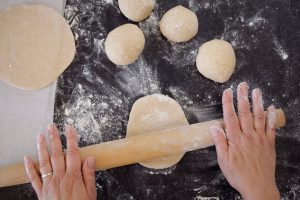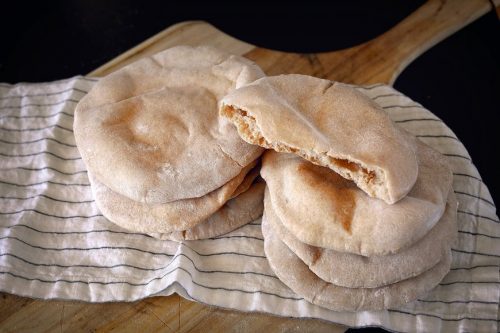By Nancy Wiechec | Catholic News Service
Bread is among the earliest prepared foods, with archeological evidence of it dating back more than 10,000 years. A primary source of nourishment for humankind, bread is replete with mythology, tradition and ritual. Scripture offers some fine examples.

Bread is mentioned hundreds of times in the Bible and appears as a life-giving spiritual food, a sacrifice and a sign of God’s love for humankind. The most significant expression of that love is found in the Eucharist, when we share in the breaking of the bread, the sacrifice made so that we might have eternal life.
Even before the Last Supper, Christ foretells this saving grace when he tells a crowd, “I am the bread of life” (Jn 6:35). “I am the living bread that came down from heaven; whoever eats this bread will live forever; and the bread that I will give is my flesh for the life of the world” (Jn 6:51).
When we consume bread, we have the energy to live on earth. When we partake in the Eucharist, we have the sustenance necessary to transcend the world and live forever with God.
Made from two essential ingredients, grain and water, bread has a long and fascinating history. Its earliest form was likely a paste that was thrown on a hot rock to cook. The art of bread making is said to have been honed by the ancient Egyptians. That heritage is honored in Egypt, where bread is called “aish,” meaning life.
In biblical lands around the time of Christ, bread was made from wheat, barley, millet and spelt. Women took on the intensive process of making bread daily. It involved harvesting the grain, threshing, winnowing, milling it by hand into flour and preparing the dough. They might have taken their dough to “bakers’ street” (Jer 37:21) for professional baking. Otherwise, dough was baked or fried at home.

Jesus’ breaking of the bread at the Last Supper is a Jewish tradition. At the start of a meal, the head of household blesses the bread with this prayer: “Blessed are you, Lord our God, king of the universe, who brings forth bread from the earth.” The bread is broken and then shared with all at the table.
Usually, when we think about bread in the Bible, the unleavened variety comes to mind because of its essential presence at Passover and the Last Supper. But bread leavened with wild yeast or ferments was common.
In the Gospel of Matthew, Jesus compares the action of expanding dough to heaven: “The kingdom of heaven is like yeast that a woman took and mixed with three measures of wheat flour until the whole batch was leavened” (Mt 13:33).
This recipe makes a type of leavened flatbread that people in the Middle East have eaten for at least 4,000 years. Pita takes less time to make than a loaf of bread and is an excellent vehicle for on-the-go meals.
WHOLE WHEAT PITA BREAD
Active time: 30 minutes
Nonactive time: 1.5 hours
Servings: 8 pitas
- 1 cup lukewarm water
- 2 teaspoons active dry yeast
- 1 tablespoon honey
- 1 1/4 cups (180 grams) whole wheat flour
- 1 1/2 cups (180 grams) unbleached all-purpose flour
- 1 teaspoon kosher salt
- 1 tablespoon extra-virgin olive oil

Mix the water, honey and yeast in the bowl of a stand mixer. Let it sit for 5 minutes.
Add the flours, salt and olive oil to the yeast mixture and mix with a dough hook for about 2 minutes until all ingredients come together in a shaggy dough. Cover the bowl with plastic wrap or a clean damp towel and let the dough rest for 15 minutes.
Remove the cover. With the mixer on low, knead the dough for 5 minutes until it’s smooth and elastic. If the dough seems too sticky, add a tablespoon more of all-purpose flour.
Form the dough into a ball and place it in an oiled bowl. Cover with plastic wrap and allow the dough to rise until doubled in size, about an hour.
Gently deflate the dough and turn it out onto a lightly floured work surface. Divide it into 8 equal pieces and shape each piece into a ball.
Using a rolling pin, roll each ball into a circle about 6 inches wide. Lift and turn the dough as you roll so it doesn’t stick to the work surface. Add more flour to the surface if the dough starts to stick.
Place the circles of dough on a sheet of parchment paper. Cover with plastic wrap or a clean damp towel while the oven preheats.
Place a baking stone or a heavy baking sheet on the middle rack of the oven and preheat to 450 degrees.
When the oven is ready (it will take a good 30 minutes to preheat), carefully transfer 2 to 3 disks of dough at a time onto the baking surface and bake for 4 to 5 minutes until the pitas fully puff up.
Remove the pitas from the oven with a wide spatula and cool on a rack. Repeat with the remaining circles of dough.
Fill the pitas with meat, cheese and veggies. Or cut them into triangles, lightly toast and serve with hummus or another favorite dip. You can store cooled pitas in a zip-close bag for up to 3 days.
Note: Accurately measuring ingredients for bread is important. This recipe gives the flour measurements in cups and grams. If you have a kitchen scale, use it to measure the flour in grams. If not, lightly spoon the flour into a measuring cup and level the top with a straight edge. Packing the flour into the cup or scooping it up from the bag leads to incorrect amounts.






















